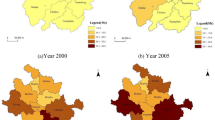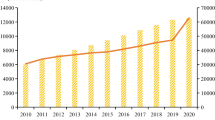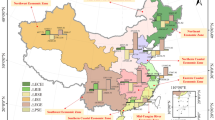Abstract
To reduce carbon emissions effectively in Shandong province in New Normal economy, this paper presents a new way to reflect the situation of carbon emissions accurately from both time-perspective and spatial perspective. The characteristics of carbon emissions in Shandong province are presented during 2005–2014, and this paper explores the spatial autocorrelation of carbon emissions branches in 17 cities. The results show that the total amount of carbon emissions in Shandong province presented a steady growth, whereas the growth rate was low, and the proportion of coal consumption in energy structure was significantly higher than the national average. In addition, the spatial pattern of the carbon emissions in 17 cities presented obvious regionally distinction. Furthermore, the affecting factors governing carbon emissions are decomposed based on the Kaya identity. The results reveal that economic scale was the key factor to increase the carbon emissions, whereas energy efficiency was the main factor of carbon emissions reduction. Therefore, this paper draws government should promote carbon emissions reduction given priority to some regions virtually, while encouraging emission reduction in others.


Source Authors’ own drawing

Source Authors’ own drawing

Source Authors’ own drawing

Source Authors’ own drawing

Source Authors’ own drawing

Source Authors’ own drawing

Source Authors’ own drawing

Source Authors’ own drawing

Source Authors’ own drawing

Source Authors’ own drawing
Similar content being viewed by others
Notes
To keep the consistence of study period and the accurate comparison, relative data of indicators, e.g., the total energy consumption, GDP and population, is obtained since 2004.
References
Ang BW, Xu XY (2013) Tracking industrial energy efficiency trends using index decomposition analysis. Energy Econ 40:1014–1021
Ayres R, Voudouris V (2014) The economic growth enigma: capital, labor and useful energy? Energy Policy 64:16–28
Cantore N, Padilla E (2010) Equality and CO2 emissions distribution in climate change integrated assessment modeling. Energy 35(1):298–313
China Climate Change Info-Net (2014) USA–China joint announcement on climate change. 2014, http://www.ccchina.gov.cn/nDetail.aspx?newsId=49275&TId=66
Chong WHB, Guan D, Guthrie P (2012) Comparative analysis of carbonization drivers in China’s megacities. J Ind Ecol 16(4):564–575
Feng K, Siu YL, Guan D et al (2012) Analyzing drivers of regional carbon dioxide emissions for China a structural decomposition analysis. J Ind Ecol 16(4):600–611
Feng K, Davis SJ, Sun L, Li X, Guan D, Liu W et al (2013) Outsourcing CO2 within China. Proc Natl Acad Sci USA 110(28):11654–11659
Guo J, Zhang Z, Meng L (2012) China’s provincial CO2 emissions embodied in international and interprovincial trade. Energy Policy 42:486–497
Hanson D, Laitner JA (2004) An integrated analysis of policies that increase investments in advanced energy-efficient/low-carbon technologies. Energy Econ 26(4):739–755
Ingwersen WW, Garmestani AS, Gonzalez MA, Templeton JJ (2014) A systems perspective on responses to climate change. Clean Technol Environ Policy 16(4):719–730
IPCC (2006) IPCC guidelines for national greenhouse gas inventory. Intergovernmental Panel on Climate Change, Hayama
IPCC (2013) Summary for policymakers of climate change 2013: the physical science basis. Contribution of working group I to the fifth assessment report of the Intergovernmental Panel on Climate Change. Cambridge University Press, Cambridge. pp 4–6
Kawase R, Matsuoka Y, Fujino J (2006) Decomposition analysis of CO2 emission in long-term climate stabilization scenarios. Energy Policy 34:2113–2122
Kurganova IN, Lopes de Gerenyu VO, Petrov AS, Myakshina TN, Sapronov DV, Ableeva VA, Kudeyarov VN (2011) Effect of the observed climate changes and extreme weather phenomena on the emission component of the carbon cycle in different ecosystems of the southern taiga zone. Dokl Biol Sci 441(1):412–416
Levitt CJ, Pedersen MS, Sørensen A (2015) Examining the efforts of a small, open economy to reduce carbon emissions: the case of Denmark. Ecol Econ 119:94–106
Li P, Cao Y (2013) Spatial and temporal changes of industrial carbon emissions under regional industrial transfer: the case of Pan-Yangtze River Delta. Adv Earth Sci 28(8):939–947
Li G, Li Z (2010) Regional difference and influence factors of China’s carbon dioxide emissions. China Popul Resour Environ 20(5):22–27
Li B, Zhang J, Li H (2011) Research on spatial-temporal characteristics and affecting factors decomposition of agricultural carbon emission in China. China Popul Resour Environ 21(8):80–86
Liang S, Zhang TZ (2011) What is driving CO2 emissions in a typical manufacturing center of South China? The case of Jiangsu Province. Energy Policy 39(11):7078–7083
Ma D, Hu S, Zhu B, Jin Y (2012) Carbon substance flow analysis and CO2 emission scenario analysis for China. Clean Technol Environ Policy 14(5):815–825
Mckay GA (1991) The changing atmosphere: a review. Nat Hazards 4(4):353–372
Meng B, Xue J, Feng K, Guan D, Fu X (2013) China’s inter-regional spillover of carbon emissions and domestic supply chains. Energy Policy 61:1305–1321
Ning X, Zhang J, Qin Y et al (2014) Spatial and temporal characteristics of carbon emissions from urban resident travel in Zhengzhou. Resour Sci 36(5):1021–1028
Peters GP (2008) From production-based to consumption-based national emission inventories. Ecol Econ 65(1):13–23
Peters GP, Hertwich EG (2008) CO2 embodied in international trade with implications for global climate policy. Environ Sci Technol 42(5):1401–1407
Qu J, Li J, Zhang Z et al (2014) Analysis of China’s provincial carbon dioxide emission spatiotemporal pattern. Econ Geogr 34(9):158–165
Schandl H, Dodds SH, Wiedmann T, Geschke A, Cai Y, West J, Newth D, Baynes T, Lenzen M, Owen A (2015) Decoupling global environmental pressure and economic growth: scenario for energy use, materials use and carbon emission. J Clean Prod. doi:10.1016/j.jclepro.2015.06.100
Song D, Xu A (2011) Regional difference and influential factors if China’s urban carbon emissions. China Popul Resour Environ 21(11):8–14
Wang YF, Zhao HY, Li LY, Liu Z, Liang S (2013) Carbon dioxide emission drivers for a typical metropolis using input-output structural decomposition analysis. Energy Policy 58:312–318
Xu D (2010) Analysis of regional differences of carbon emissions structure in China. Jiangxi Soc Sci 4:79–82
Yang S (2015) The temperature of China has increased 0.23 °C per decade on an average. Guangming Daily 2015-03-23006
Yildirim E, Sukruoglu D, Aslan A (2014) Energy consumption and economic growth in the next 11 countries: the bootstrapped autoregressive metric causality approach. Energy Econ 44:14–21
Zelm RV, Roy PO, Hauschild MZ, Huijbregts AJ (2015) LCA compendium—the complete world of life cycle assessment. In: Hauschild MZ, Huijbregts AJ (eds) Life cycle impact assessment. Springer, Netherlands, pp 163–176. doi:10.1007/978-94-017-9744-3_9
Zhang M, Liu X, Wang W, Zhou M (2013) Decomposition analysis of CO2 emissions from electricity generation in China. Energy Policy 52:159–165
Zhang Y, Liu Z, Zhang H, Tan T (2014) The impact of economic growth, industrial structure and urbanization on carbon emission intensity in China. Nat Hazards 73(2):579–595
Zhang M, Song Y, Su B, Sun X (2015a) Decomposing the decoupling indicator between the economic growth and energy consumption in China. Energy Effic 8:1231–1239
Zhang Q, Nakatai J, Moriguchi Y (2015b) Compilation of an embodied CO2 emission inventory for China using 135-sector input–output tables. Sustainability 7(7):8223–8239
Acknowledgements
This work was supported by the Fundamental Research Funds for the National Social Science Foundation of China (14BGL159), Shandong Province Natural Science Key Fund Project (ZR2015GZ003), Shandong Province Social Science Planning Project (13CDYJ27), Fundamental Research Funds for the Central Universities (2015XKMS069), and the Natural Science Foundation of Jiangsu Province (BK20160246). We are grateful to two anonymous for their comments and suggestions that have helped to improve considerably the paper. Nonetheless, we are of course responsible for all errors and omissions.
Author information
Authors and Affiliations
Corresponding authors
Rights and permissions
About this article
Cite this article
Zhang, H., Sun, X. & Wang, W. Study on the spatial and temporal differentiation and influencing factors of carbon emissions in Shandong province. Nat Hazards 87, 973–988 (2017). https://doi.org/10.1007/s11069-017-2805-7
Received:
Accepted:
Published:
Issue Date:
DOI: https://doi.org/10.1007/s11069-017-2805-7




